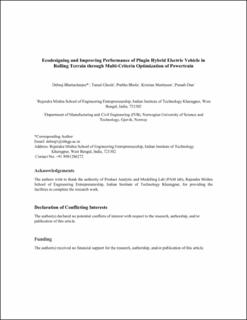| dc.description.abstract | This work presents an ecodesigning and operating performance improvement methodology in series-parallel Plugin hybrid electric vehicle (PHEV) in passenger car category, through optimisation of powertrain, considering gradeability overreaching rolling terrain. Designing involves consideration for power of prime movers and the geometric specification governing gear ratio, which is the teeth number. PHEV performance is measured in terms of various output characteristics, such as, fuel economy, emissions, vehicle weight, battery charge, maximum velocity and maximum acceleration etc. and such output indicators comprising both ecodesign and vehicle operating performance attributes, eleven in all, are considered. For optimisation, the design space is generated using NREL, ADVISOR simulator in accordance with Taguchi’s method. Multi-criteria optimisation is used to converge the aforesaid output indicators into a single one using TOPSIS, MTOPSIS, Grey Relational Analysis and their surrogate assisted evolutionary algorithm (SAEA) based solutions to select the best from. Such design solutions are tested with UDDS driving cycle for performance analysis; reflecting superiority of SAEA based results. However, best values of output indicators are not from a single solution but are spread over these SAEAs. While, gradability is embedded in the model, its variation as supplemental factor, together with total ownership cost, are included, for extended modelling to ascertain the suitability amongst SAEAs. To extend the test for suitability beyond one driving cycle, also a combined one is formed by integrating two other, namely NEDC and 1015Prius with UDDS. The simulation experiment results from combined driving cycle also indicate preference in favour of MTOPSIS-SAEA model, complying upto 25% gradability for rolling terrain, substantially better than the reference model while also ensuring savings in fuel cost by about 60% over the entire ownership period besides reduction in greenhouse gas emissions ranging between 18% and 21%. This solution also helps in lightweighting the vehicle by over 6%. | en_US |

